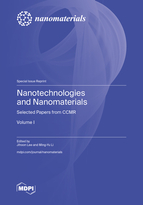Nanotechnologies and Nanomaterials: Selected Papers from CCMR
A special issue of Nanomaterials (ISSN 2079-4991).
Deadline for manuscript submissions: closed (30 September 2022) | Viewed by 178084
Special Issue Editors
Interests: understanding physical, chemical, and biological materials of various compositions and morphologies, including carbon nanotubes, graphene, oxide materials, polymer, molecules, nanoparticles, nanowires, quantum, dots, etc.
Special Issues, Collections and Topics in MDPI journals
Interests: nanomaterials synthesis; photodetectors; solar cells; fabrication of plasmonic nanostructures; pyroelectric thin films; nanocomposites for pyroelectric energy harvesting, etc.
Special Issues, Collections and Topics in MDPI journals
Special Issue Information
Dear Colleagues,
Nanomaterials research, the science and technologies for the generation, processing, and fabrication of materials, is where disciplines merge and where they diverge into a remarkable range of applications, from electronics to health care, which touch, or will soon touch, the lives of millions. The collaborative conference on materials research (CCMR) series aims to enable technological developments in the various fields of materials and to further the goal of unifying nanomaterials research in engineering, physics, biology, materials science, as well as chemistry and neuroscience.
This Special Issue, “Nanotechnologies and Nanomaterials: Selected Papers from CCMR”, will contain the accepted papers presented during the CCMR series, related to ‘nanotechnologies and nanomaterials’. The selected papers will include nanomaterials preparation, modification, characterization, properties, and the applications of any compositions and morphologies, including carbon nanotubes, graphene, metal, oxide materials, polymer, molecules, nanoparticles, nanowires, quantum dots, etc.
Prof. Dr. Jihoon Lee
Dr. Ming-Yu Li
Guest Editors
Manuscript Submission Information
Manuscripts should be submitted online at www.mdpi.com by registering and logging in to this website. Once you are registered, click here to go to the submission form. Manuscripts can be submitted until the deadline. All submissions that pass pre-check are peer-reviewed. Accepted papers will be published continuously in the journal (as soon as accepted) and will be listed together on the special issue website. Research articles, review articles as well as short communications are invited. For planned papers, a title and short abstract (about 100 words) can be sent to the Editorial Office for announcement on this website.
Submitted manuscripts should not have been published previously, nor be under consideration for publication elsewhere (except conference proceedings papers). All manuscripts are thoroughly refereed through a single-blind peer-review process. A guide for authors and other relevant information for submission of manuscripts is available on the Instructions for Authors page. Nanomaterials is an international peer-reviewed open access semimonthly journal published by MDPI.
Please visit the Instructions for Authors page before submitting a manuscript. The Article Processing Charge (APC) for publication in this open access journal is 2900 CHF (Swiss Francs). Submitted papers should be well formatted and use good English. Authors may use MDPI's English editing service prior to publication or during author revisions.
Keywords
- Advanced alloy materials
- Biomaterials and applications
- Catalytic materials and applications
- Electronic materials and applications
- Energy materials
- Graphene and applications
- Light emitting materials
- Magnetism and magnetic materials
- Materials synthesis and characterizations
- Materials theory and principles
- Molecular systems and applications
- Nanostructures and nanomaterials
- Optoelectronic materials
- Oxide materials
- Photovoltaics photocatalysis materials
- Plasmonics and applications
- Polymers and applications
- Quantum matters and applications
- Sensors and applications








